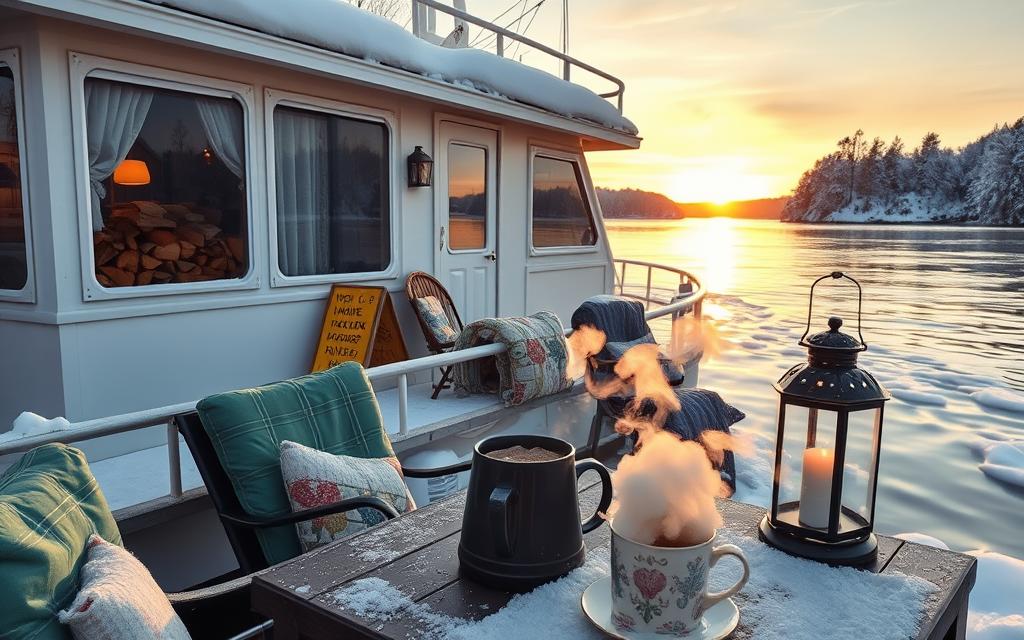Table of Contents
As the weather gets colder and the leaves change, it’s time to winterize your houseboat. This is key to keep your boat safe and ready for the next boating season. In this guide, I’ll show you how to winterize your houseboat. We’ll cover everything from why it’s important to the steps to protect your boat’s systems.
Key Takeaways
- Understand the common winter damage issues that can occur without proper winterization
- Learn the cost benefits of preventive winterization to save money in the long run
- Discover the best time to start the winterization process for your houseboat
- Gather the essential tools and materials needed for a successful winterization
- Protect your water systems, engine, and mechanical systems from the cold
Understanding the Importance of Proper Houseboat Winterization
Winterizing your houseboat is key to keeping it safe from cold weather. If you don’t do it, you might face problems like frozen pipes and engine issues. Taking care of your houseboat now will save you money and trouble later.
Common Winter Damage Issues
The cold weather can harm your houseboat in many ways. Some common problems include:
- Frozen and burst water pipes, leading to water leaks and structural damage
- Engine and mechanical failures due to exposure to cold temperatures
- Moisture buildup and mold growth within the cabin, compromising the interior
- Weather-related damage to the exterior, such as cracked or dislodged siding
Cost Benefits of Preventive Winterization
Winterizing your houseboat might cost money upfront, but it saves you more in the long run. It prevents expensive repairs and keeps your boat in good shape. Plus, it saves you from the stress of dealing with a broken-down boat during the boating season.

Best Time to Start Winterization
The best time to start winterizing your houseboat depends on where you live. Generally, start a few weeks before the first freeze. This gives you enough time to get your boat ready for winter. Starting early helps you avoid last-minute stress and ensures your boat is winter-ready.
“Proper winterization is the best investment you can make to protect your houseboat and ensure it’s ready for the next season.”
SHORTCODE FOR NEWSLETTER:-
Essential Tools and Materials Needed for Winterization
Getting your houseboat ready for winter needs the right tools and materials. The right equipment makes winterizing easier and more efficient. This ensures your boat is safe from cold weather. Here’s a list of must-haves for winterizing your houseboat.
Winterization Checklist for Houseboats
- Antifreeze – High-quality, marine-grade antifreeze is a must-have for protecting your houseboat’s water systems from freezing.
- Lubricants – Stock up on marine-specific lubricants, such as engine oil, transmission fluid, and grease, to keep your mechanical components running smoothly.
- Cleaning Supplies – You’ll need various cleaning products, including boat wash, wax, and protectants, to prepare the interior and exterior for storage.
- Specialized Equipment – Invest in tools like winterization kits, bilge pumps, and shrink wrap to ensure a thorough and professional-grade winterization.
- Safety Gear – Don’t forget personal protective equipment (PPE) like gloves, goggles, and respirators to stay safe during the winterization process.
| Item | Purpose | Quantity Needed |
|---|---|---|
| Marine Antifreeze | Protect water systems from freezing | 5-10 gallons |
| Engine Oil | Lubricate and protect engine components | 4-6 quarts |
| Boat Wax | Protect the exterior surface from weathering | 1-2 cans |
| Winterization Kit | Specialized tools for a complete winterization | 1 kit |
By getting the right winterization checklist for houseboats, you’re set to protect your investment. Your houseboat will be ready for winter. Having the right tools and materials makes winterizing easy and effective.
Draining and Protecting Your Water Systems
Keeping your houseboat’s water systems safe is key to avoiding expensive damage from cold weather. Let’s look at how to winterize your fresh water tank, plumbing, and hot water heater.
Fresh Water Tank Winterization
Draining your fresh water tank is the first step. This step stops freezing and prevents cracks or leaks. Make sure to turn off the water pump and open all faucets to empty the tank completely.
Plumbing System Protection
Now, let’s talk about your plumbing system. Disconnect hoses and use compressed air to clear water from pipes. This stops ice from forming and prevents pipes from bursting. Don’t forget to drain your water heater, sinks, and shower too.
Hot Water Heater Care
Lastly, we have your hot water heater. Drain the tank and disconnect the power to protect it. A little water left in the tank is okay, but always check the manufacturer’s winterization guide.
By draining and protecting your houseboat’s water systems, you’ll avoid ice damage and have a smooth spring launch. These easy steps can save you a lot of time and money.
How to Winterize Your Houseboat Engine and Mechanical Systems
Winterizing your houseboat’s engine and systems is key to avoid expensive damage. It also makes sure your boat is ready for spring. As a marine winterization services expert, I’ll show you how to protect your investment.
First, change the engine oil. Old oil can cause wear and corrosion. Fresh oil and a fuel stabilizer in the tank will keep your engine safe.
Then, protect against corrosion. Fogging the engine cylinders with a lubricant creates a protective layer. This stops moisture and rust from harming your engine.
- Drain the engine coolant and refill with a 50/50 mix of antifreeze and water to prevent freezing.
- Disconnect the battery and store it in a cool, dry place, ensuring it’s fully charged when it’s time to reinstall.
- Inspect the belts and hoses, replacing any that show signs of wear or cracking.
Don’t forget about your houseboat’s other systems. Winterize the generator, air conditioning, and more as the manufacturer suggests. Proper marine winterization services will keep your boat in great shape and save you money on repairs.
| Task | Benefit |
|---|---|
| Change Engine Oil | Prevents wear and corrosion |
| Add Fuel Stabilizer | Prevents fuel breakdown and clogs |
| Fog Engine Cylinders | Protects against moisture and rust |
| Winterize Mechanical Systems | Safeguards longevity and prevents costly repairs |
By taking these steps, your houseboat’s engine and systems will be ready for winter. With the right marine winterization services, you’ll have a smooth launch when boating season starts again.
Interior Preparation and Protection Measures
When getting your houseboat ready for winter, don’t forget the inside. Protecting the interior is just as important as the outside. By controlling moisture, taking care of furniture and appliances, and stopping pests, you keep your houseboat looking great all winter.
Moisture Control Methods
Too much moisture can harm your houseboat’s inside. Use a good dehumidifier to keep humidity in check. Also, put moisture-absorbing sachets or bags around to soak up any dampness. Always check for and fix any leaks to stop mold and mildew.
Furniture and Appliance Care
Looking after your houseboat’s furniture and appliances helps them last longer and look better. Clean everything well, then cover cushions and fabrics with breathable, acid-free stuff to stop fading and damage. Make sure appliances are turned off, cleaned, and covered from dust and pests during winter.
Pest Prevention Strategies
- Seal all entry points: Look for any cracks or openings that pests could use to get in, and seal them up with caulk or other sealants.
- Use natural repellents: Put cedar chips, cotton balls with peppermint oil, or other natural pest keepers in key spots around the houseboat.
- Consider professional pest control: For extra security, think about getting a pest control service to check and treat your houseboat before you store it for winter.
By following these steps, you can keep your houseboat in top shape all winter. It will be ready for you to enjoy when the weather warms up and it’s time to storing a houseboat during winter.
Exterior Winterization and Hull Protection
Keeping your houseboat safe from winter’s harsh weather is key to its long life. Proper exterior winterization protects your vessel’s hull and other parts.
This ensures it stays in great shape all winter. Let’s explore the important steps to protect your houseboat from cold and keep it looking good.
Hull Cleaning and Waxing
Before winter, clean and wax your houseboat’s hull. This makes it look better and protects it from the weather. Scrub the hull to remove dirt, then wax it to seal in the shine and protect against damage.
Protecting Deck Hardware
Deck hardware like cleats and railings can rust in winter. Clean and coat these parts to prevent rust. Use a marine-grade lubricant or rust-inhibiting spray to keep them in good shape.
Securing Covers and Tarps
Using good covers or tarps protects your houseboat from the weather. Cover the deck, windows, and other exposed areas to stop water and snow damage. Make sure the covers are tight and won’t flap in the wind.
| Exterior Winterization Task | Importance |
|---|---|
| Hull Cleaning and Waxing | Enhances appearance and creates a protective barrier |
| Protecting Deck Hardware | Prevents rusting and corrosion of critical components |
| Securing Covers and Tarps | Shields the houseboat from water, snow, and wind damage |
By doing these key exterior winterization tasks, you can keep your houseboat safe from cold weather. This ensures it stays in great shape until spring comes.

“Proper exterior winterization is the key to safeguarding your houseboat’s investment and preserving its beauty for years to come.”
Professional Services vs. DIY Winterization
Preparing your houseboat for winter offers two choices: hiring professionals or doing it yourself. Understanding the advantages and disadvantages of each can guide you to the best choice for your budget and needs.
Cost Comparison Analysis
Professional marine winterization services cost between $500 and $1,000. This price includes draining water systems, protecting engines, and preparing your houseboat for cold weather. It might seem expensive, but it’s a good investment for protecting your boat.
DIY winterization is cheaper, costing $100 to $300 for supplies. But, it requires time and effort. There’s also a risk of mistakes that could cost more later.
When to Call the Professionals
- If you lack experience in houseboat maintenance in cold climates
- If you don’t have the necessary tools or equipment for marine winterization services
- If you’re concerned about the complexity of the winterization process
- If you want to ensure your houseboat is fully protected and ready for the winter season
Insurance Considerations
Think about how your winterization choice affects your insurance. Some insurers need professional winterization to keep coverage. Others might give discounts for it. Always check with your insurance provider.
Choosing between professional services and DIY depends on your skills, resources, and how much you value your houseboat’s safety. By considering these factors, you can make sure your boat is ready for winter and ready to sail when it’s warm again.
Storage Options and Considerations
Choosing the right storage for your houseboat is key to keeping it safe during winter. There are several options, each with its own benefits and things to think about.
In-Water Storage
In-water storage is a common choice, where the houseboat stays in the water. This can be handy because you don’t have to move it. But, make sure it’s winterized well to avoid damage from cold and ice.
Dry Dock Storage
Dry dock storage lifts the houseboat out of the water and puts it on land. This keeps it safe from the weather and water damage. You might need to cover it or store it in a special place.
Indoor Facilities
Storing your houseboat indoors, like in a heated building, offers the best protection. It’s the most expensive option but keeps your boat safe from everything.
When picking a storage spot for your houseboat, think about cost, how easy it is to get to, and how much protection you need. Talk to local marinas, boatyards, or storage places to find the best choice for your boat.

Proper storage is essential for protecting your houseboat from the harsh winter conditions, ensuring it remains in top shape for the next boating season.
Conclusion
In this guide, I’ve covered the key steps to winterize your houseboat. We’ve looked at why it’s important and how to protect your boat’s systems. This includes water, engine, and interior.
As spring comes, de-winterizing your houseboat is just as important. By reversing the winter steps, you’ll get your boat ready for the new season. Make sure to check your water systems, engine, and interior carefully.
By following these winter and de-winter steps, you’ll protect your investment. You’ll avoid expensive repairs and enjoy your houseboat without worries. Remember, a little prevention goes a long way in keeping your boat in top shape.
FAQ
Why is proper houseboat winterization important?
Winterizing your houseboat is key to avoiding costly damage in cold months. Without it, you might face frozen pipes, engine harm, and water damage. These issues can be pricey to fix in the spring.
When is the best time to start the winterization process?
Start winterizing your houseboat in the fall, before it gets too cold. Try to finish by a month before you stop using it for the season. This ensures your boat is safe and ready for winter.
What are the essential tools and materials needed for houseboat winterization?
You’ll need antifreeze, lubricants, cleaning stuff, and covers or tarps. Also, tools like a wet/dry vacuum and compressed air are important. Having the right tools makes the job easier and more effective.
How do I properly winterize my houseboat’s water systems?
It’s vital to protect your water systems from freezing damage. Drain the freshwater tank and blow out the plumbing with air. Don’t forget to care for your hot water heater. These steps keep your water systems safe through winter.
What steps are involved in winterizing the engine and mechanical systems?
Winterizing the engine and systems means changing the oil and adding fuel stabilizer. You also need to fog the cylinders and protect against corrosion. Remember to winterize the generator, steering, and electrical systems too. This ensures they’re ready for storage.
How do I prepare and protect the interior of my houseboat for winter?
To prepare the interior, control moisture, care for furniture and appliances, and prevent pests. This keeps your houseboat’s interior in good shape during the off-season. It also makes it ready for spring use.
What exterior winterization steps should I take to protect my houseboat?
Clean and wax the hull, protect deck hardware, and secure covers or tarps. These steps protect your houseboat’s exterior from damage. They also help it look great during winter.
Should I hire professional services for houseboat winterization, or can I do it myself?
Whether to DIY or hire pros depends on your skills, the boat’s complexity, and your time and budget. Pros offer a thorough job and peace of mind but cost more. DIY is good if you’re skilled and have the time. Just make sure to follow all steps for proper winterization.
What are the different storage options for my houseboat during the winter?
You can store your houseboat in water, on land, or indoors. Each option has its pros and cons, like cost, access, and protection. Think about your needs and preferences to choose the best storage for your boat.




Pingback: Navigating Your Houseboat: Tips for Beginners oceangrandeur.com
Pingback: Eco-Friendly Practices for Houseboating: A Comprehensive Guide oceangrandeur.com
Pingback: Tips for Maintaining Your Houseboat Anchoring System oceangrandeur.com